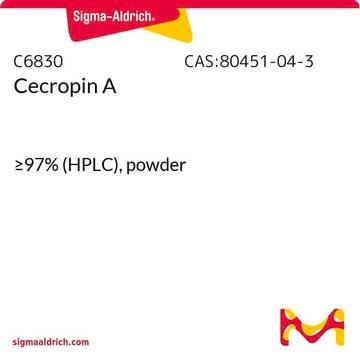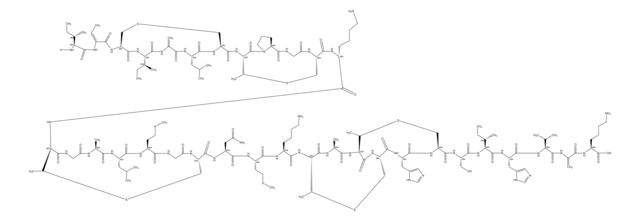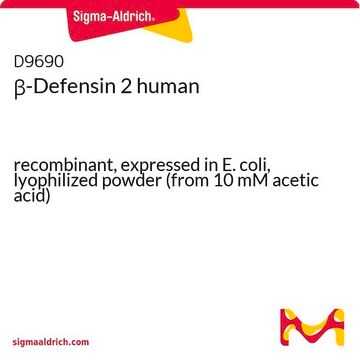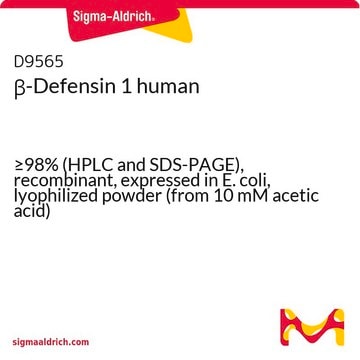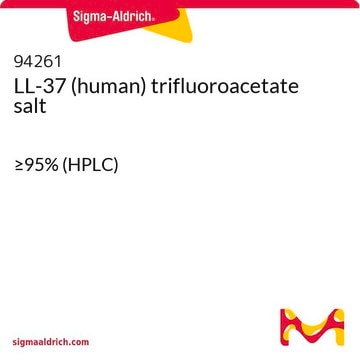C1796
Cecropin B
≥97% (HPLC), powder
Seleccione un Tamaño
MXP 4,925.00
Seleccione un Tamaño
About This Item
MXP 4,925.00
Productos recomendados
Nivel de calidad
Ensayo
≥97% (HPLC)
Formulario
powder
espectro de actividad antibiótica
fungi
Modo de acción
cell membrane | interferes
temp. de almacenamiento
−20°C
cadena SMILES
S(CC[C@H](NC(=O)[C@@H](NC(=O)[C@@H](NC(=O)[C@@H](NC(=O)[C@@H](NC(=O)[C@@H](NC(=O)[C@@H](NC(=O)[C@@H](NC(=O)[C@@H](NC(=O)[C@@H](NC(=O)[C@@H](N)CCCCN)Cc3c4c([nH]c3)cccc4)CCCCN)C(C)C)Cc2ccccc2)CCCCN)CCCCN)[C@H](CC)C)CCC(=O)O)CCCCN)C(=O)NCC(=O)N[C@@H](CCCN\C(
InChI
1S/C176H302N52O41S/c1-25-97(15)140(174(269)224-139(96(13)14)168(263)212-113(57-36-43-72-179)155(250)199-101(19)145(240)198-91-134(234)228-79-50-64-128(228)167(262)202-104(22)149(244)225-141(98(16)26-2)171(266)203-105(23)148(243)222-137(94(9)10)169(264)219-123(82-93(7)8)152(247)196-89-132(232)205-119(65-67-135(235)236)156(251)201-102(20)146(241)206-112(56-35-42-71-178)154(249)200-103(21)147(242)215-122(144(187)239)81-92(5)6)221-133(233)90-197-153(248)126(85-129(185)229)217-160(255)118(63-49-78-193-176(190)191)213-172(267)143(100(18)28-4)227-166(261)127(86-130(186)230)218-157(252)111(62-48-77-192-175(188)189)204-131(231)88-195-151(246)121(69-80-270-24)211-159(254)114(58-37-44-73-180)207-161(256)120(66-68-136(237)238)214-173(268)142(99(17)27-3)226-163(258)117(61-40-47-76-183)208-158(253)115(59-38-45-74-181)209-164(259)124(83-106-51-30-29-31-52-106)220-170(265)138(95(11)12)223-162(257)116(60-39-46-75-182)210-165(260)125(216-150(245)109(184)54-34-41-70-177)84-107-87-194-110-55-33-32-53-108(107)110/h29-33,51-53,55,87,92-105,109,111-128,137-143,194H,25-28,34-50,54,56-86,88-91,177-184H2,1-24H3,(H2,185,229)(H2,186,230)(H2,187,239)(H,195,246)(H,196,247)(H,197,248)(H,198,240)(H,199,250)(H,200,249)(H,201,251)(H,202,262)(H,203,266)(H,204,231)(H,205,232)(H,206,241)(H,207,256)(H,208,253)(H,209,259)(H,210,260)(H,211,254)(H,212,263)(H,213,267)(H,214,268)(H,215,242)(H,216,245)(H,217,255)(H,218,252)(H,219,264)(H,220,265)(H,221,233)(H,222,243)(H,223,257)(H,224,269)(H,225,244)(H,226,258)(H,227,261)(H,235,236)(H,237,238)(H4,188,189,192)(H4,190,191,193)/t97-,98-,99-,100-,101-,102-,103-,104-,105-,109-,111-,112-,113-,114-,115-,116-,117-,118-,119-,120-,121-,122-,123-,124-,125-,126-,127-,128-,137-,138-,139-,140-,141-,142-,143-/m0/s1
Clave InChI
YIQHNFUJWYYSEC-MQAAYMCRSA-N
Amino Acid Sequence
Descripción general
Aplicación
Acciones bioquímicas o fisiológicas
Otras notas
Código de clase de almacenamiento
11 - Combustible Solids
Clase de riesgo para el agua (WGK)
WGK 3
Punto de inflamabilidad (°F)
Not applicable
Punto de inflamabilidad (°C)
Not applicable
Equipo de protección personal
Eyeshields, Gloves, type N95 (US)
Elija entre una de las versiones más recientes:
¿Ya tiene este producto?
Encuentre la documentación para los productos que ha comprado recientemente en la Biblioteca de documentos.
Los clientes también vieron
Active Filters
Nuestro equipo de científicos tiene experiencia en todas las áreas de investigación: Ciencias de la vida, Ciencia de los materiales, Síntesis química, Cromatografía, Analítica y muchas otras.
Póngase en contacto con el Servicio técnico